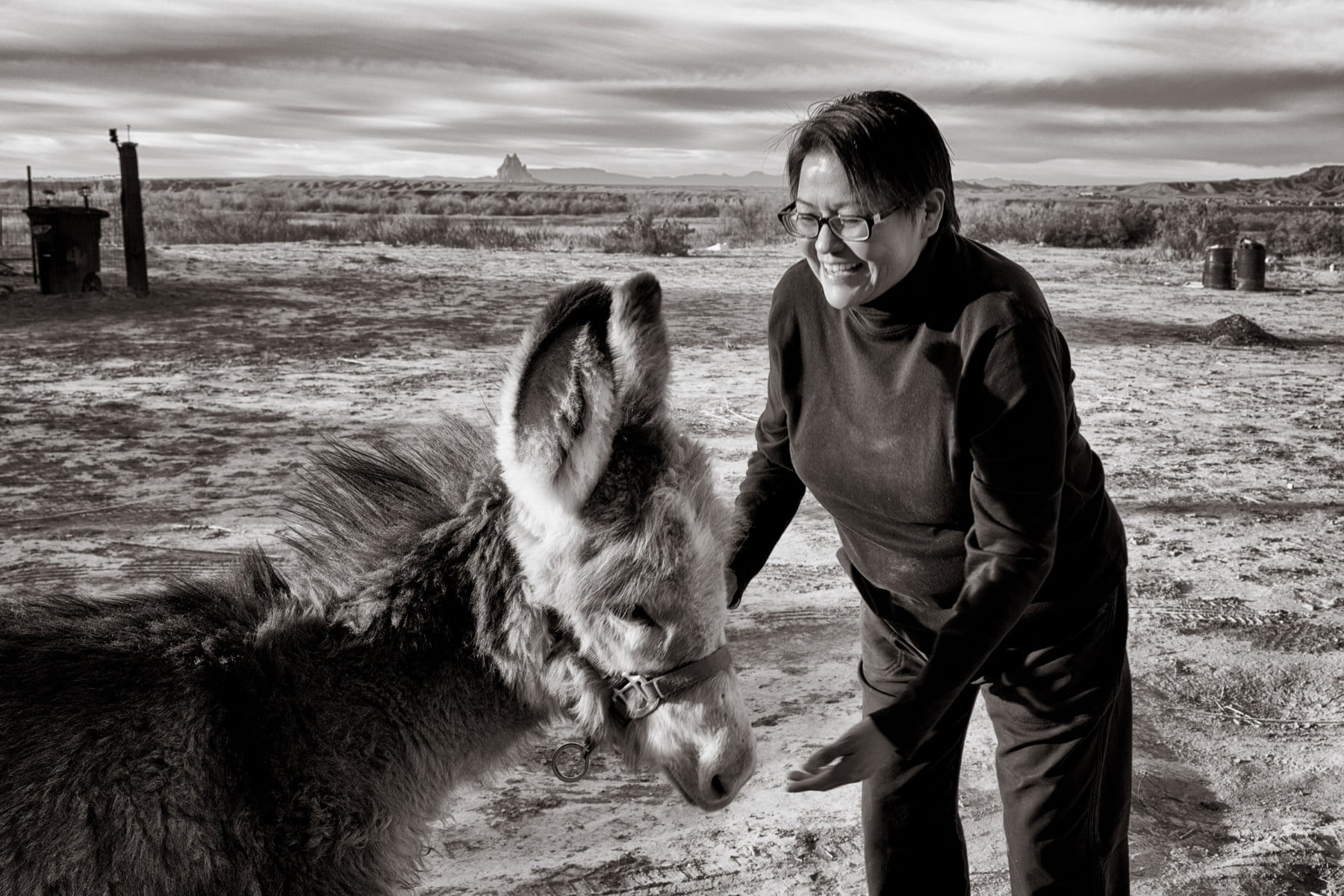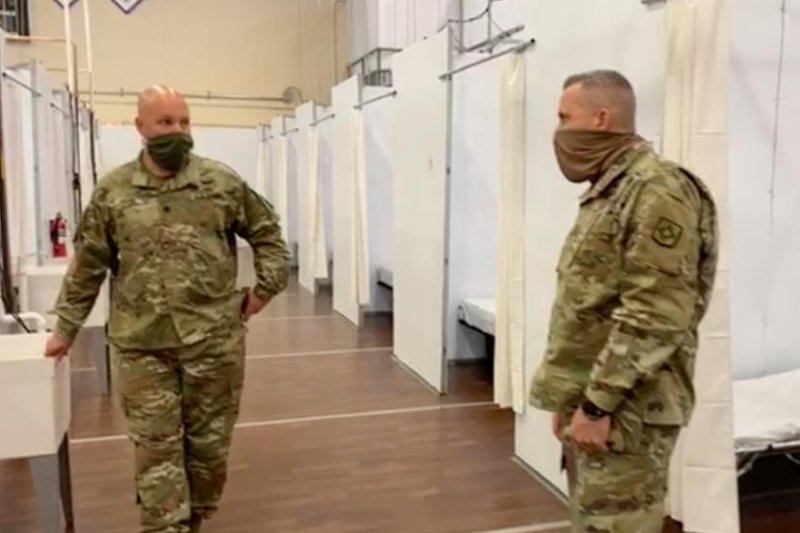By MICHAEL PHILLIS

1 of 8
A sign marks Navajo Drive, as Sentinel Mesa, homes and other structures in Oljato-Monument Valley, Utah, on the Navajo Reservation, stand in the distance, on April 30, 2020. The U.S. Supreme Court will soon decide a critical water rights case in the water-scarce Southwest. The high court will hold oral arguments Monday, March 20, 2023, in a case with critical implications for how water from the drought-stricken Colorado River is shared and the extent of the U.S. government’s obligations to Native American tribes.
States that rely on water from the over-tapped Colorado River want the U.S. Supreme Court to block a lawsuit from the Navajo Nation that could upend how water is shared in the Western U.S.
The tribe doesn’t have enough water and says that the federal government is at fault. Roughly a third of residents on the vast Navajo Nation don’t have running water in their homes.
More than 150 years ago, the U.S. government and the tribe signed treaties that promised the tribe a “permanent home” — a promise the Navajo Nation says includes a sufficient supply of water. The tribe says the government broke its promise to ensure the tribe has enough water and that people are suffering as a result.
The federal government disputes that claim. And states, such as Arizona, California and Nevada, argue that more water for the Navajo Nation would cut into already scarce supplies for cities, agriculture and business growth.
The high court will hold oral arguments Monday in a case with critical implications for how water from the drought-stricken Colorado River is shared and the extent of the U.S. government’s obligations to Native American tribes.
A win for the Navajo Nation won’t directly result in more water for the roughly 175,000 people who live on the largest reservation in the U.S. But it’s a piece of what has been a multi-faceted approach over decades to obtain a basic need.
Tina Becenti, a mother of five, made two or three short trips a day to her mom’s house or a public water spot to haul water back home, filling several five-gallon buckets and liter-sized pickle jars. They filled slowly, sapping hours from her day. Her sons would sometimes help lift the heavy containers into her Nissan SUV that she’d drive carefully back home to avoid spills.
“Every drop really matters,” Becenti said.
That water had to be heated then poured into a tub to bathe her young twin girls. Becenti’s mother had running water, so her three older children would sometimes go there to shower. After a couple of years, Becenti finally got a large tank installed by the nonprofit DigDeep so she could use her sink.
DigDeep, which filed a legal brief in support of the Navajo Nation’s case, has worked to help tribal members gain access to water as larger water-rights claims are pressed.
Extending water lines to the sparsely populated sections of the 27,000 square-mile (69,000 square-kilometer) reservation that spans three states is difficult and costly. But tribal officials say additional water supplies would help ease the burden and create equity.
“You drive to Flagstaff, you drive to Albuquerque, you drive to Phoenix, there is water everywhere, everything is green, everything is watered up,” said Rex Kontz, deputy general manager of the Navajo Tribal Utility Authority. “You don’t see that on Navajo.”
The tribe primarily relies on groundwater to serve homes and businesses.
For decades, the Navajo Nation has fought for access to surface water, including the Colorado River and its tributaries, that it can pipe to more remote locations for homes, businesses and government offices.
It’s a legal fight that resonates with tribes across the U.S., said Dylan Hedden-Nicely, the director of the Native American Law Program at the University of Idaho and an attorney representing tribal organizations that filed a brief in support of the Navajo Nation.
The Navajo Nation has reached settlements for water from the San Juan River in New Mexico and Utah. Both of those settlements draw from the Colorado River’s Upper Basin.
The tribe has yet to reach agreement with Arizona and the federal government for water rights from the Colorado River in the Lower Basin that includes the states of California, Arizona and Nevada. It also has sought water from a tributary, the Little Colorado River, another major legal dispute that’s playing out separately.
In the U.S Supreme Court case, the Navajo Nation wants the U.S. Department of the Interior to account for the tribe’s needs in Arizona and come up with a plan to meet those needs.
A federal appeals court ruled the Navajo Nation’s lawsuit could move forward, overturning a decision from a lower court.
Attorneys for the Navajo Nation base their claims on two treaties the tribe and the U.S. signed in 1849 and 1868. The latter allowed Navajos to return to their ancestral homelands in the Four Corners region after being forcibly marched to a desolate tract in eastern New Mexico.
The Navajo Nation wants the Supreme Court to find that those treaties guaranteed them enough water to sustain their homeland. And the tribe wants a chance to make its case before a lower federal court.
The federal government says it has helped the tribe get water from the Colorado River’s tributaries, but no treaty or law forces officials to address the tribe’s general water needs. The Interior Department declined to comment on the pending case.
“We absolutely think they’re entitled to water, but we don’t think the lower Colorado River is the source,” said Rita Maguire, the attorney representing states in the Lower Basin who oppose the tribe’s claims.
If the Supreme Court sides with the Navajo Nation, other tribes might make similar demands, Maguire said.
Arizona, Nevada and California contend the Navajo Nation is making an end run around another Supreme Court case that divvied up water in the Colorado River’s Lower Basin.
“The first question in front of the court now is: why is the lower court dealing with the issue at all?” said Grant Christensen, a federal Indian law expert and professor at Stetson University.
Even if the justices side with the Navajo Nation, the tribe wouldn’t immediately get water. The case would go back to the U.S. District Court in Arizona, and rights to more water still could be years, if not, decades away. The Navajo Nation also could reach a settlement with Arizona and the federal government for rights to water from the Colorado River and funding to deliver it to tribal communities.
Tribal water rights often are tied to the date a reservation was established, which would give the Navajo Nation one of the highest priority rights to Colorado River water and could force conservation on others, said Hedden-Nicely of the University of Idaho.
Given the likelihood of a long road ahead, Kontz of the Navajo Tribal Utility Authority says many older Navajo won’t live to see running water in their homes.
Becenti, the 42-year-old mother of five, remembers shedding tears of joy when running water finally was installed in her house and her family could use a flushable indoor toilet.
It was a relief to “go to the facility without having to worry about bugs, lizards, snakes,” she said.
___
The Associated Press receives support from the Walton Family Foundation for coverage of water and environmental policy. The AP is solely responsible for all content. For all of AP’s environmental coverage, visit https://apnews.com/hub/climate-and-environment




























